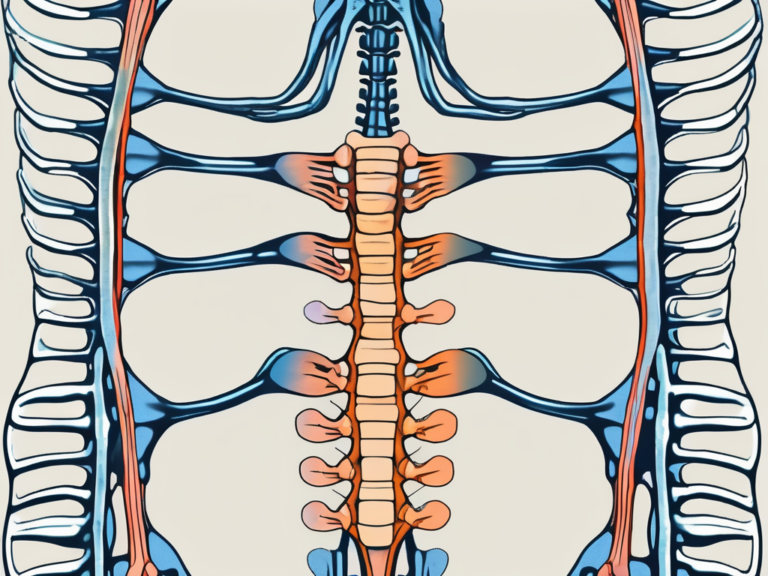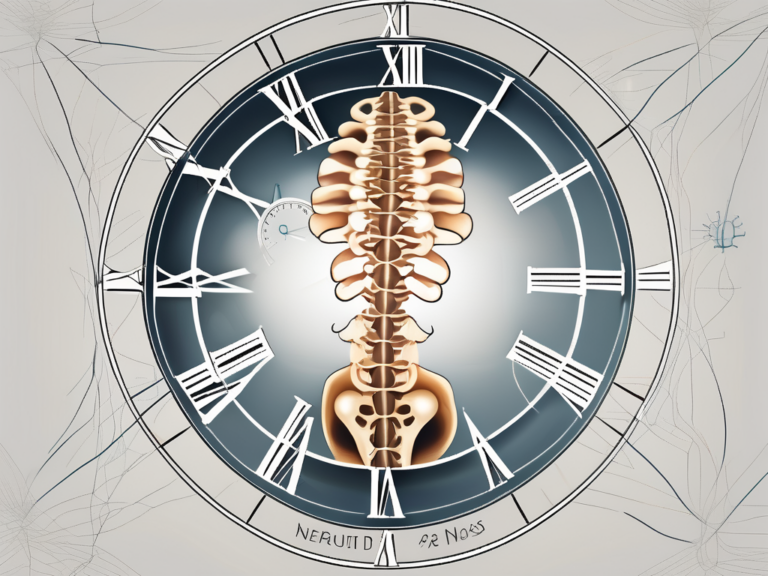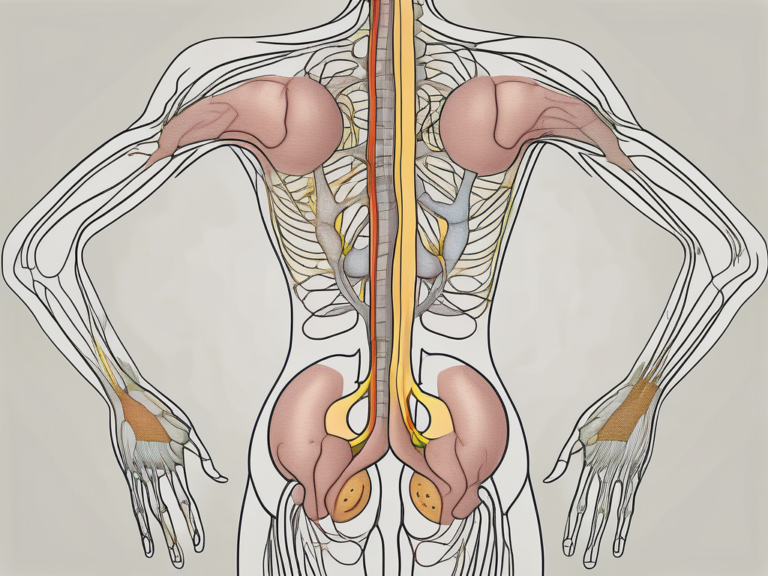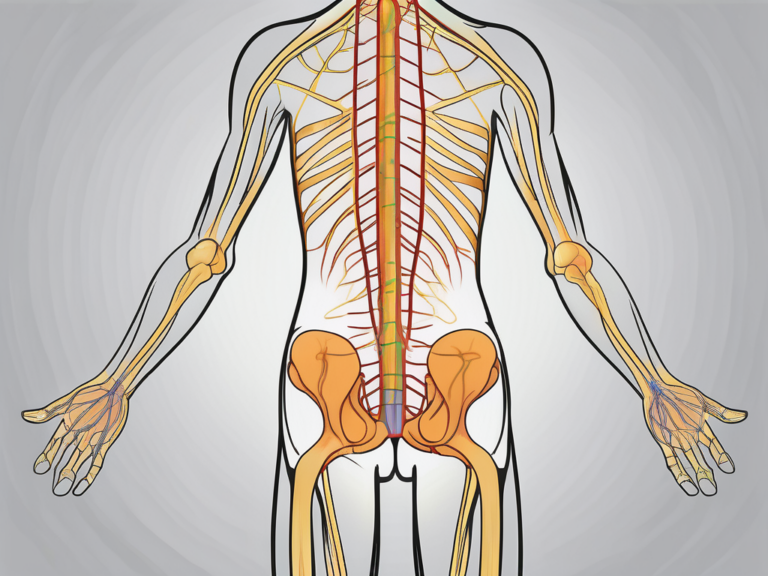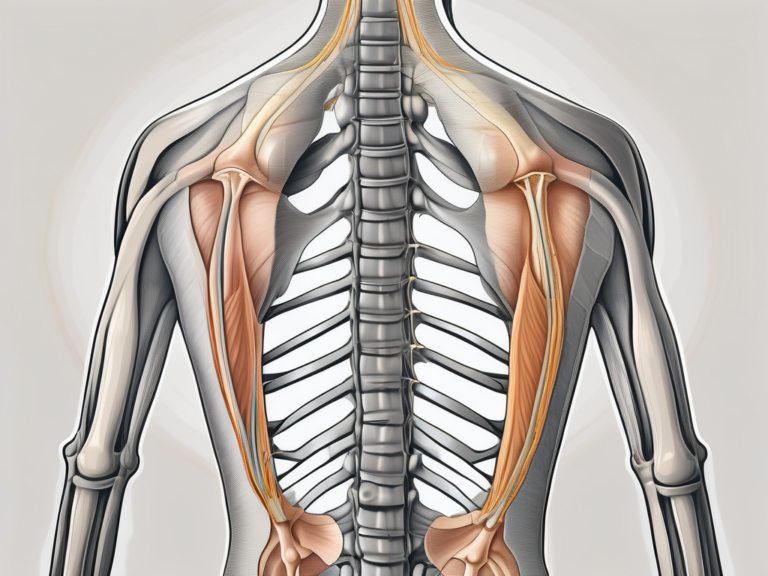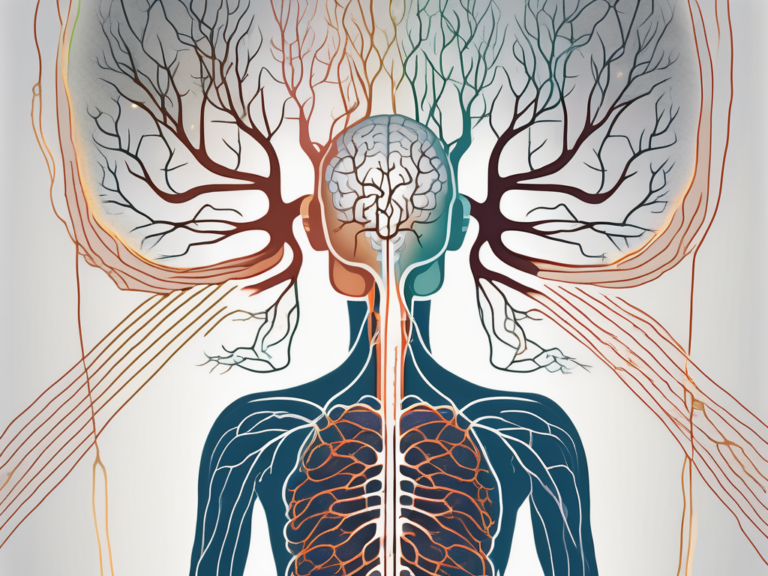Where to Place Pads of TENS for Sacral Nerve Stimulation
Understanding TENS and Sacral Nerve Stimulation
Before delving into the intricacies of pad placement, it’s essential to have a basic understanding of how TENS therapy and sacral nerve stimulation work.
When it comes to managing chronic pain conditions, such as arthritis, fibromyalgia, and lower back pain, TENS therapy has emerged as a popular and effective treatment option. TENS stands for Transcutaneous Electrical Nerve Stimulation, and it works by sending electrical signals through the skin to stimulate the sensory nerves. By doing so, it affects the body’s perception of pain and provides relief to individuals suffering from persistent discomfort.
But how exactly does TENS therapy achieve this pain-relieving effect? The electrical signals generated by the TENS device travel through the skin and reach the nerves responsible for transmitting pain signals to the brain. By stimulating these sensory nerves, TENS therapy essentially “overrides” the pain signals, reducing their intensity and providing a sense of relief.
The Basics of TENS Therapy
TENS therapy involves the use of a small, portable device that delivers electrical currents to specific areas of the body. The device consists of electrodes, also known as pads, which are placed on the skin near the site of pain or discomfort. These electrodes are connected to the TENS unit, which controls the intensity and frequency of the electrical signals.
When the TENS device is turned on, it begins to deliver electrical pulses to the electrodes. These pulses can be adjusted to different frequencies and intensities, depending on the individual’s needs and preferences. The electrical signals travel through the skin and stimulate the sensory nerves, effectively interfering with the transmission of pain signals to the brain.
TENS therapy is considered a safe and non-invasive treatment option for chronic pain management. It is often used as an alternative to medication or in conjunction with other therapies to provide comprehensive pain relief.
The Role of Sacral Nerves in the Body
While TENS therapy is commonly associated with managing chronic pain, it can also be used to stimulate the sacral nerves and improve various bodily functions. The sacral nerves, located in the lower part of the spine, play a crucial role in regulating bladder and bowel control, sexual function, and lower limb movement.
When the sacral nerves are not functioning properly, individuals may experience issues such as urinary or fecal incontinence, sexual dysfunction, or difficulty with mobility. In these cases, sacral nerve stimulation through TENS therapy can be beneficial.
By targeting the sacral nerves with electrical stimulation, TENS therapy can help improve bladder and bowel control, enhance sexual function, and promote better lower limb movement. The electrical signals generated by the TENS device activate the sacral nerves, prompting them to send appropriate signals to the muscles and organs involved in these bodily functions.
It’s important to note that sacral nerve stimulation through TENS therapy should be performed under the guidance of a healthcare professional. They will determine the appropriate pad placement and settings to achieve the desired therapeutic effects.
In conclusion, TENS therapy and sacral nerve stimulation are valuable treatment options for managing chronic pain and improving various bodily functions. By understanding the basics of how TENS therapy works and the role of sacral nerves in the body, individuals can make informed decisions about incorporating these therapies into their pain management strategies.
Preparing for TENS Therapy
Before starting TENS therapy, it’s vital to take certain safety measures and gather the necessary equipment. TENS therapy, also known as Transcutaneous Electrical Nerve Stimulation, is a non-invasive treatment that uses low-voltage electrical currents to relieve pain. It is commonly used to manage chronic pain conditions such as arthritis, back pain, and fibromyalgia.
When considering TENS therapy, it is important to consult with a healthcare professional. They can evaluate your specific condition and determine if TENS therapy is suitable for you. Your healthcare professional can provide guidance on the proper usage of the TENS unit and address any concerns you may have about the treatment.
Safety Measures Before Starting TENS Therapy
Prior to initiating TENS therapy, it is crucial to ensure that you are taking the necessary safety measures. Your healthcare professional will assess your medical history and evaluate if TENS therapy is appropriate for your condition. They will consider factors such as the presence of pacemakers, epilepsy, or any other medical conditions that may affect the use of electrical stimulation.
Additionally, it is important to follow the instructions provided by your healthcare professional or the manufacturer of the TENS unit. This includes properly cleaning and maintaining the TENS unit and pads to prevent any potential infections or skin irritations.
Necessary Equipment for TENS Therapy
To administer TENS therapy, you will need a TENS unit, also known as a stimulator, and TENS pads. The TENS unit is a portable device that delivers electrical currents through the TENS pads to the targeted area of pain. These pads are self-adhesive and easily attach to the skin in the desired area.
When selecting a TENS unit, it is important to choose one that suits your specific needs. Consider factors such as the number of channels, intensity levels, and additional features that may enhance your therapy experience. Your healthcare professional can guide you in selecting the most appropriate TENS unit for your condition.
Ensure you have a sufficient supply of TENS pads that are compatible with your TENS unit. It is recommended to have extra pads on hand to replace them when they lose their adhesive properties or become worn out. Regularly check the condition of the pads to ensure optimal performance and effectiveness of the therapy.
In conclusion, before starting TENS therapy, it is essential to prioritize safety and gather the necessary equipment. Consulting with a healthcare professional, following safety measures, and having the appropriate TENS unit and pads will help ensure a successful and beneficial TENS therapy experience.
Placement of TENS Pads for Sacral Nerve Stimulation
Correct pad placement is crucial for targeting the sacral nerves effectively. Familiarize yourself with the sacral area and ensure proper positioning of the TENS pads.
Identifying the Sacral Area
The sacral area refers to the lower part of the back, just above the tailbone. It encompasses the sacrum, a triangular bone consisting of five fused vertebrae. Spend a few moments locating this area before proceeding further.
The sacrum plays a vital role in supporting the weight of the upper body and connecting the spine to the pelvis. It is an essential component of the vertebral column and provides stability and strength to the lower back region.
Understanding the anatomy of the sacral area is essential for accurate pad placement. By identifying the sacrum, you can ensure that the TENS pads are positioned correctly to target the sacral nerves effectively.
Correct Positioning of TENS Pads
Place the TENS pads on the sacral area, on either side of the spine. It’s essential to maintain the recommended distance between the pads, which can vary depending on your specific condition. Generally, a distance of one to two inches is sufficient.
The sacral nerves are responsible for transmitting sensory and motor signals to and from the lower extremities, pelvic organs, and the lower back. By placing the TENS pads on either side of the spine, you can directly stimulate these nerves and alleviate pain or discomfort in the sacral region.
When positioning the pads, ensure they are centered over the sacral nerves. You may need to adjust the placement slightly until you feel the sensations generated by the TENS therapy in the desired areas.
It’s important to note that everyone’s anatomy is unique, and the exact positioning of the TENS pads may vary from person to person. Experiment with different placements to find the most effective position for your individual needs.
Additionally, the size and shape of the TENS pads can also impact their effectiveness. Larger pads may provide a broader coverage area, while smaller pads can target specific points with more precision. Consider experimenting with different pad sizes to find the optimal configuration for your sacral nerve stimulation therapy.
Remember to always follow the instructions provided by your healthcare professional or the TENS device manufacturer when it comes to pad placement. They will have the expertise and knowledge to guide you in achieving the best results from your sacral nerve stimulation therapy.
Adjusting TENS Settings for Optimal Stimulation
Once the TENS pads are correctly positioned, it’s important to understand how to adjust the settings on your TENS unit for optimal stimulation.
When it comes to finding the right settings for your TENS unit, it’s crucial to understand the different modes available. TENS units often come with multiple modes that vary the frequency and intensity of the electrical stimulation. These modes can be customized to suit your specific needs and preferences. Experimenting with different modes can help you find the one that provides the best relief for your particular condition.
Each mode offers a unique pattern of electrical stimulation, allowing you to target different areas of discomfort or pain. Some modes may provide a continuous stream of pulses, while others may deliver pulses in bursts or waves. By exploring the various modes, you can discover which one works best for you.
Understanding the Different TENS Modes
Let’s take a closer look at some common TENS modes:
- Continuous Mode: This mode delivers a continuous stream of electrical pulses. It is often used for general pain relief and relaxation.
- Burst Mode: In this mode, the TENS unit delivers a series of rapid pulses followed by a short break. Burst mode is commonly used for acute pain management.
- Modulation Mode: Modulation mode varies the intensity and frequency of the electrical pulses, creating a more dynamic and unpredictable pattern. This mode is useful for targeting chronic pain and preventing the body from adapting to a specific stimulation pattern.
- Strength-Duration Mode: This mode combines short and long pulses to effectively stimulate both superficial and deep tissues. It is often used for conditions that require a combination of pain relief and muscle rehabilitation.
By understanding the different TENS modes and their respective benefits, you can tailor your settings to maximize the effectiveness of your treatment.
Setting the Pulse Width and Rate
Aside from selecting the appropriate mode, adjusting the pulse width and rate is crucial for achieving optimal stimulation. The pulse width refers to the duration of each electrical pulse, while the rate determines the frequency at which the pulses are delivered.
When starting with your TENS unit, it’s recommended to begin with lower settings for both the pulse width and rate. Gradually increase them until you find the balance that offers effective stimulation without causing discomfort or pain. Keep in mind that everyone’s tolerance to electrical stimulation varies, so what works for one person may not work for another.
Experimenting with different pulse widths and rates allows you to fine-tune the treatment to your specific needs. Some individuals may respond better to shorter pulses with higher frequencies, while others may find longer pulses with lower frequencies more effective. It’s important to listen to your body and make adjustments accordingly.
Remember, finding the optimal settings for your TENS unit may require some trial and error. Patience and persistence are key. Don’t be afraid to consult with a healthcare professional or the manufacturer of your TENS unit for guidance and recommendations.
Monitoring and Adjusting TENS Therapy
As you undergo TENS therapy, pay close attention to how your body responds and make any necessary adjustments to achieve optimal results.
TENS therapy, or transcutaneous electrical nerve stimulation, is a non-invasive treatment that uses low-voltage electrical currents to relieve pain. It works by sending electrical impulses through the skin to stimulate the nerves and block pain signals from reaching the brain. While TENS therapy can be highly effective in managing pain, it is important to monitor your body’s response and make adjustments as needed.
Recognizing Effective Stimulation
Effective stimulation should result in reduced pain, improved function, or a combination of both within the targeted area. It is important to pay attention to how your body responds during and after each session. If you do not experience any improvement or find the therapy ineffective, consult with your healthcare professional to discuss alternative approaches.
It is worth noting that the effectiveness of TENS therapy can vary from person to person. Factors such as the type and location of pain, individual pain tolerance, and the underlying condition can all influence the outcome. Therefore, it is crucial to monitor your progress and communicate with your healthcare provider to ensure the best possible results.
When to Adjust TENS Pad Placement
If you notice that the stimulation feels uneven or does not adequately cover the targeted area, consider adjusting the placement of the TENS pads. Proper pad placement is essential for optimal results. Experiment with slight variations until you find the most effective positioning for your specific condition.
When placing the TENS pads, it is important to consider the anatomy of the area being treated. The pads should be positioned on or near the area of pain or discomfort. For example, if you are experiencing lower back pain, the pads should be placed on either side of the spine, targeting the affected muscles or nerves.
Keep in mind that the distance between the pads can also affect the intensity of the stimulation. Placing the pads closer together will result in a more concentrated and intense sensation, while placing them farther apart will provide a broader coverage area with a milder sensation.
Additionally, the size and shape of the pads can play a role in the effectiveness of the therapy. Larger pads generally provide a wider coverage area, while smaller pads can target specific points more precisely. Experiment with different pad sizes and shapes to find what works best for you.
Remember, TENS therapy is a customizable treatment, and what works for one person may not work for another. It may take some trial and error to find the optimal pad placement and settings for your specific needs. Be patient and persistent in your adjustments, and consult with your healthcare professional for guidance along the way.
Potential Risks and Complications
While TENS therapy is generally safe and well-tolerated, it’s important to be aware of potential side effects and know when to seek medical attention.
Common Side Effects of TENS Therapy
Side effects from TENS therapy are rare but can include skin irritation or discomfort at the site of the TENS pad placement. If you experience any adverse reactions, discontinue use and consult a healthcare professional for further guidance.
When to Seek Medical Attention
If you experience severe pain, dizziness, or any unusual symptoms during TENS therapy, it is essential to seek medical attention promptly. Your healthcare provider can evaluate your condition and determine the appropriate course of action.
In conclusion, the proper placement of TENS pads is crucial for sacral nerve stimulation therapy. By understanding the basics of TENS therapy, preparing adequately, and correctly positioning the TENS pads, you can optimize the effectiveness of this treatment. As always, it is important to consult with a healthcare professional before starting TENS therapy to ensure it is suitable for your specific condition and to address any concerns or questions you may have.

